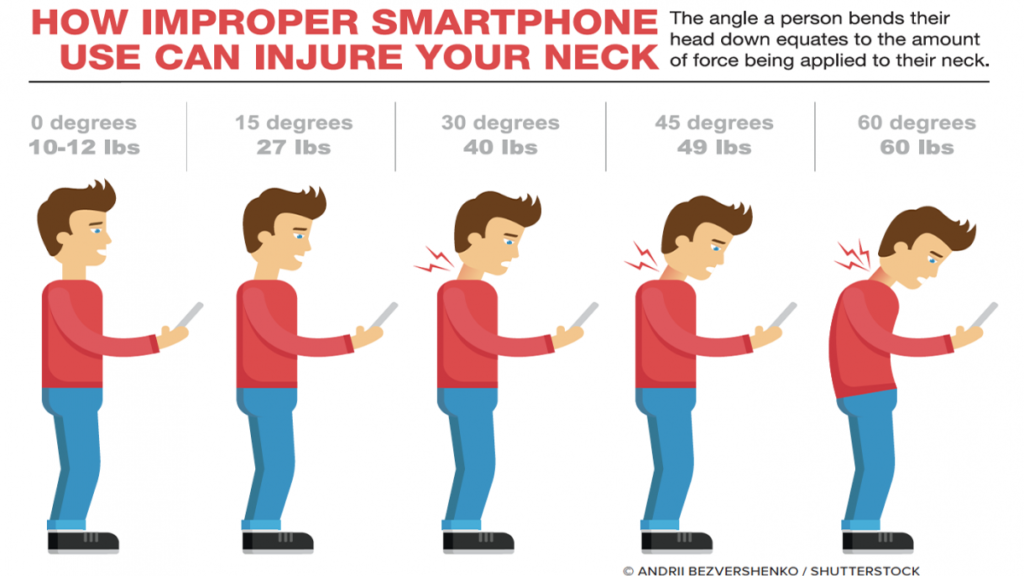Next time you’re at the gym, take a quick look around and see how many people are looking down at their phones. Notice their posture. Most likely they have their heads tucked in and shoulders hunched, overstressing their necks. What you’re seeing is called tech neck.
What is Tech Neck?
Tech neck, also referred to as cervical kyphosis, results from the hunchback slouch many of us naturally employ when using our devices. When you bend your neck forward to look at your phone or device you are placing excess strain on your spine, causing tension to your neck and shoulders and stressing your upper-back.
Symptoms of tech neck include:
- Neck pain or spasms
- Headaches
- Stiff neck
- Pain between your shoulder blades
- Tingling or numb thumbs
- Blurry vision from too much screen time
- Poor posture
When you consider how many hours a day we spend using digital media and mobile devices, hunched over — you can see why tech neck is a growing problem, especially for young adults.
Tech neck not only causes poor posture, it throws your body out of alignment and puts stress on other parts of your body. The effects of the extra stress and pressure taxes the muscles, ligaments, vertebrae, and discs in the neck and upper thoracic regions and can lead to serious chronic muscle issues and pain down the road.

Prevent Tech Neck
If you really want to prevent tech neck, you will need to spend less time sitting, less time on digital devices, and change some poor posture habits. You will need to learn how to align your body properly and practice it until it’s second nature.
Counteract the Effects of Tech Neck
Look Forward
Instead of tilting your chin down to read your phone or tablet, raise it to eye level. Do the same with your computer’s monitor or laptop. It should also be at eye level, so you don’t have to drop your head and straining your muscles.
Focus on your Posture
Learn proper neck alignment and posture by taking a look at your profile in the mirror. If you’re standing correctly, you can draw a vertical line going from your ear down to your shoulder.
Exercise, in general, will alleviate some of the muscle strains caused by tech neck. To really combat some of the longer term effects, you will want to focus on strength training and mobility exercises.
Here are a few suggested no-equipment required exercises to help counteract some of the more common effects of tech neck:
Pigeon neck: Pull your chin back to reverse forward and down positioning of your head, so your head will sit back between your shoulders. If you do this correctly, your head should align directly over your torso, relieving spinal compression and backside neck muscle strain.
Chest opening: Stand or sit while clasping your hands behind your head. Squeeze your shoulder blades back as you open your elbows up out to the side. You should feel the front of your chest stretch. Bring your shoulders and head slightly backward and arch your upper middle back to increase the stretch. Hold 20 seconds and release slowly.
Nod: Sit upright and situate your head directly over your torso. Now, your head up and down so you can feel the amount of movement you have in your topmost neck joint, where your skull connects to your cervical spine. Then, hold your nod at the bottom, creating a double chin. Don’t nod so hard you cut off your breath or hit your throat with your chin. Hold the position for 10 seconds, releasing slowly.
Postural correction/spinal decompression: Sit down on the edge of your chair with your feet turned out around a 45-degree angle and legs apart. Loosely hold your arms at your sides and face your palms forward, sitting upright in a neutral position. Now, position your back until it’s right over your shoulders and take around 10 deep breaths, inhaling and exhaling slowly. Repeat.